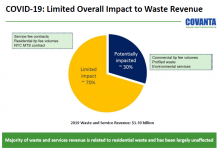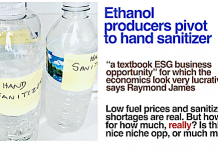by Debra Fiakas CFA
 The stark reality of basing their business model on a food commodity has been brought into sharp focus for ethanol producers. The drought settling across the U.S. corn crop is helping drive up corn prices for hog producers, chicken farms and ethanol plants alike. Investors who simply must have a position in ethanol might think the sugarcane-based ethanol producers could offer a safe haven against the supply and margin squeeze that is certain to hobble GreenPlains Renewable Energy (GPRE: Nasdaq), Pacific Ethanol (PEIX: Nasdaq) and Poet (private), among others relying on corn feedstock.
The stark reality of basing their business model on a food commodity has been brought into sharp focus for ethanol producers. The drought settling across the U.S. corn crop is helping drive up corn prices for hog producers, chicken farms and ethanol plants alike. Investors who simply must have a position in ethanol might think the sugarcane-based ethanol producers could offer a safe haven against the supply and margin squeeze that is certain to hobble GreenPlains Renewable Energy (GPRE: Nasdaq), Pacific Ethanol (PEIX: Nasdaq) and Poet (private), among others relying on corn feedstock.
Think again! Cosan Ltd. (CZZ: NYSE) is one of Brazil’s leading ethanol producers and sources sugarcane from other farmers as well as its own farms. After strong growth at the beginning of calendar year 2011, adverse weather conditions got the best of Cosan as well. Crushed sugar cane volumes declined year-over-year as did ethanol and sugar volumes. In the fiscal year ending March 2012, Cosan reported a 10.9% gross margin, well below the prior fiscal year profit of 16.1%.
Cosan is not a unique case in Brazil. In calendar year 2011, Brazil produced 5.6 billion gallons, representing 25% of the world’s total ethanol used as fuel. This compares to 7.5 billion gallons in 2010. As the year unfolded politicians began getting nervous. In August 2011, in anticipation of further ethanol production declines, the Brazilian government took measures to prevent shortages by lowering Brazil’s gasoline blend requirement from 25% to 20%. Nonetheless, in the dramatic volume decline, Brazil is struggling to meet domestic demand for ethanol.
Thus it is not just the use of food commodities for ethanol feedstock, it is the use of crops that are particularly susceptible to weather extremes. It is clear the renewable energy sector has a long way to go to perfect technologies and business models. Unfortunately, cellulosic ethanol technologies remain illusive and drought resistant crops require years to perfect. In the meantime, investors could simply accept what has not been fixed. Use seasonal and cyclical influences to establish long positions in corn and ethanol at value prices….or take profits in short-positions previously established at cycle peaks.
Debra Fiakas is the Managing Director of Crystal Equity Research, an alternative research resource on small capitalization companies in selected industries.
Neither the author of the Small Cap Strategist web log, Crystal Equity Research nor its affiliates have a beneficial interest in the companies mentioned herein.








